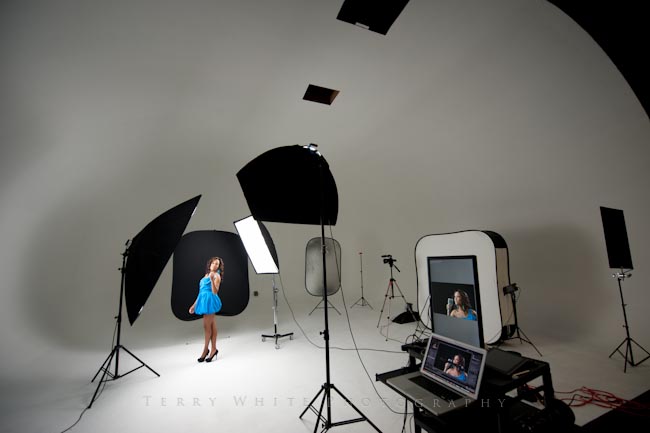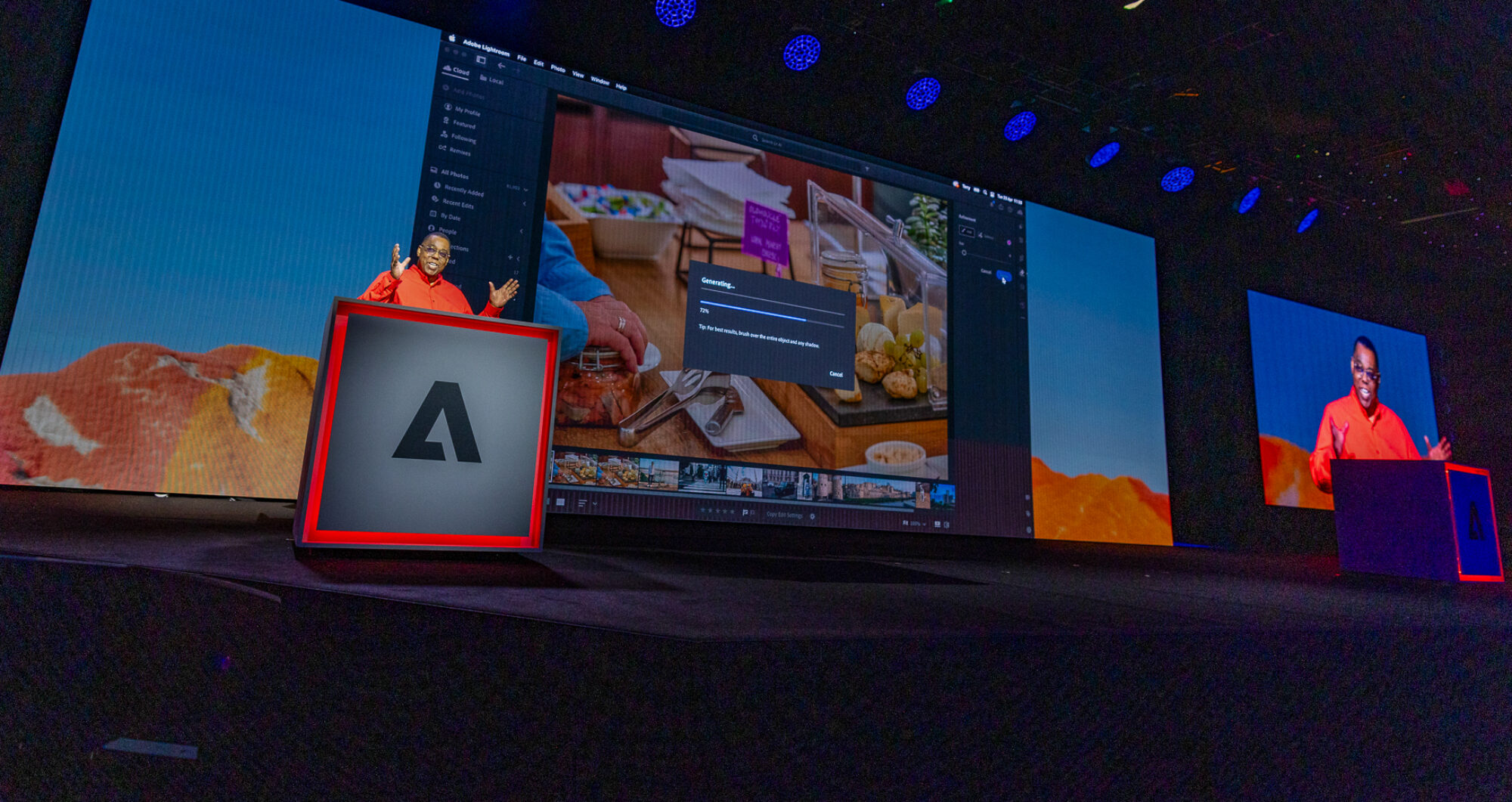
Yesterday I told you about how I broke my Nikon D700 again via a tethering accident. What I didn't mention was that I still had another shoot to do while the D700 was being repaired. I went to my backup body, which is a D7000. I love my D7000, but this was the first time that I actually used it during a studio shoot. I had no real issues with the camera or setup, but what I quickly realized was that there is a disadvantage to having more megapixels. The D7000 is a 16.2 MP camera, while my D700 is a 12.1 MP camera. If you do the math (it's not hard) there's a 4 MP increase in the image captured. What this translates to is that my RAW files on the D700 are about 10.4MB (average) in size and my D7000 DNGs are about 16MB (average) in size. This means that every shot is going be roughly about 6MBs larger than the ones coming from the D700.
Why is a larger file/higher megapixel image a bad thing?
The first thing I noticed that shooting tethered was taking longer. It makes sense. I'm used to a certain rhythm from the time I fire the shutter till the time image is displayed in Lightroom. There was a noticeable lag. The second problem was that my drive was running low on space and during the shoot I got a warning from the OS that I was basically out of space. I had to make some room right then and there. My shoots can range anywhere from 300-1,000 images. While I could have run out of space with either camera, the point is I probably ran out of space faster with the larger files coming from the D7000.
The Bottom Line
I'm not saying that camera manufacturers shouldn't build cameras capable of capturing more megapixels. What I am saying is that more megapixels no longer influences my buying decision. While I await the rumored Nikon D800 and D4, I cringe at the rumored specs of 38 Megapixels! Imagine having every photo you take be significantly larger in size whether you need it or not. I would much rather these guys build a 38MP camera (one model) for the guys that really need it and leave the rest of the line at a more reasonable/manageable MP number.
Less is more 🙂
Added note for clarification: I would welcome the larger MP images if the camera manufactures would also add the faster transfer technologies (ie. USB 3, 802.11n, Thunderbolt, etc.) into the bodies as well. What I'm saying above is that I don't just want more megapixels and nothing else. If you're going to make the files bigger then also make the transfers faster too!


I think the same.. in fact when I shoot tethered with my canon 5dII I use the SRAW of 10 megapixels, because the full raw (21 mp) is too heavy!
If it is just a matter of file size, why not set your camera at lower resolution? There seems to be a trend in sensors to decrease the number of pixels, but increase the size of each pixel. Canon is doing this in their camcorders and getting superior results, especially in low light situations. With DSLRs including more video, I would expect to see this in the DSLRs also.
Canon decreased the number of megapixel in their G series of compact cameras as well.
Switching to lower resolution will not help as you are not able to use RAW then. On the other hand I think the problem with much more data will be solved by Moore’s law quickly.
What I see as more problematic is the choice in the trade-off between the number of megapixels and the amount of useful data each pixel can get – e. g. noise to signal ratio, but especially the dynamic range of the camera. Less megapixels with dynamic range comparable with negative film will be a big advantage for me personally.
Once you start making prints in sizes like 60cm x 90cm, you’ll appreciate the additional resolution … I found that I can ideed make posters that size with reasonable quality from pictures shot with my D300s, but it is definitely not optimal.
That being said, Canon allows you to choose lower resolutions than the sensor maximum, even when shooting RAW (at least they did on the 5d Mk II last time I used one), which I think is a great feature that Nikon should adopt, too.
Another issue with all the megapixels is that once you start getting into the 22 MP region, the resolution of the lenses actually becomes a limiting factor for quality. Medium format cameras like the Hasselblad H4D series can deal with that problem more easily since they have bigger sensors and bigger lenses, but on full frame 35mm sensors, you are effectively recording unnecessary data.
Some time ago – when Kodak made digital cameras – they made the 14N. It was unusual in the face that you could choose the size of RAW file – as well as the size and compression of jpeg…
It offered three sizes of RAW – and the photographer I knew who used it choose the middle size for most of his work – which at the time was 2000×300- pixel.
I have no issue with cameras having large pixel counts – and if you could select the RAW size depending on the job – so in the case of the D4 – perhaps if it is 38 meg – have the choice of full res – middle res, perhaps 16 meg and a low res of perhaps 12…..
The other thing, why has no-one followed the route that Fuji had with the S5 – where you had double sensors to extend the tonal range – and they also allowed that to be switched on and off – so in a controlled situation like the studio it was off to keep the files smaller….
While disk space increases with time together with file size (or better said, price of disk space falls with time …) data transfer protocols are not smoothly catching up, so USB 2.0 is already slow to real time tethering. Will next camera have USB 3.0? Does my notebook have USB 3.0?
I would still prefer it wireless 🙂
Yeah, I’m not convinced, Terry, because current technology already has solutions for your problems, though it requires keeping one’s hardware up-to-date. Instead of having your files fill up your computer’s HD, off load them directly to a 1 TB external HD. Hard drive size paired with the reduced file size allowed by recent camera bodies takes care of it, and when new bodies are built with USB 3.0 or Thunderbolt interfaces, the speed won’t be a problem for you.
But there’s nothing here that you don’t already know, which makes me think that your frustration is about having to adjust your hardware (and therefore workflow) to adjust for increased file sizes.
Stephen I have no problem with keeping up with the latest hardware as I usually do!
Aside from having more drive space (which is not a problem as I simply moved some older shoots to another drive), what latest innovations am I missing today? Are there Nikon bodies with USB 3, 802.11n or Thunderbolt right now? My complaint is about today’s equipment, not what may come in the distant future. Also as far as these newer technologies are concerned, camera manufacturers are usually the last ones to adopt them. What I don’t want is a new camera with more megapixels and nothing else. If they were to add faster transfer technologies along with the bigger file sizes then by all means bring it on, but I think we know that won’t be the case for a long long time.
If newer cameras came with bigger gobs of pixels and required you to suck them all down, that wouldn’t be good (if you didn’t have a need for them). But the cameras don’t. You can choose raw small, raw med and full raw. So more MP cameras with this technology still allows you to use smaller files — no problem, right? And while camera companies are slow with the relevant transfer technologies, you can still remove the CF cards and download with usb 3 or FW 800 readers. That, I realize, is an interruption if you prefer to tether.
If the new Nikons offer RAW small then problem solved. Not hopeful since the current models (at least the ones I have) don’t offer that option.
Terry, as far as tethering goes, I think you misdiagnosed the problem. The problem is not that you have too much data in your images — the problem is that USB is just too slow to handle that much data.
USB just doesn’t have the bandwidth for a fast paced tethered shoot. That’s precisely why i don’t use tethering, as much as I’d love to. When I’m in studio, I ususally shoot with a D3x — forget about USB tethering.
I think that until camera and computer manufactures can come up with a faster technology to move data from camera to computer, we are stuck to lower resolution if we want to tether at a good clip.
Another option, far simpler I would think, would be for the camera to record a high-rez file to the CF card, but send a low-rez JPEG down the USB wire for tethering purposes. I would think this could be done with camera firmware update.
Maybe someday Nikon will update the WT-4.. or build its functionality into Nikon’s next generation of pro cameras.
The problem is that you add more time and the need for more computing power into every step from the capture forward. It would be like us old film photographers having to shoot 4×5 for everything.
I had much rather see more development in the quality and range of the sensor not more mega pixels.
Amen brutha! Amen!
Some cameras these days have reduced size RAW file options, but there’s a but (or is that two buts). The EOS 5MkII has a couple of reduced RAW options. However, the one closest to the file size created by the original EOS 5 isn’t as sharp as the files from the original 5. I have both, but if I prefer the smaller file I use the older camera in preference to the newer one set to capture smaller sized RAW files.
If camera manufacturers are going to keep increasing the resolution they need to work harder to produce better reduced size RAW files.
A D4 with Thunderbolt would be great. Now we just need some cool Thunderbolt external hard drives that don’t require a mortgage – as if I could get one.
Well, I feel your pain. We shoot hundreds if not thousands of captures weekly to Lightroom through Canon 1Ds mk IIIs, 5D mk IIs and the slow but much larger Hasselblads. And even occasionally the a stray D3. You get used to the “wait” based on the gear. And remember some gear still does not play nice with Lightroom 3 let alone Lion OS. Not at all.
Plus we shoot through to the Adobe. Never directly to it.
Our reps keep asking why we don’t Eye-Fi to the iPads but you think you’re seeing slow??? HAh!
And n means nothing compared to even USB 2 or Firewire 400/800.
We are all early adopters by definition! Or as one clown (rep) once told me the “bleeding edge”.
And I’ve shot digital since 4 MP Leaf backs cost $36K each in 1994 mounted on ELMs and ELXs…